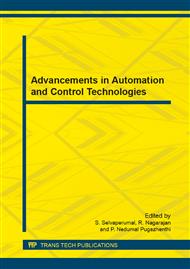p.808
p.814
p.819
p.825
p.830
p.836
p.842
p.848
p.856
Optrode Based Polymer for the Estimation of Free Chlorine
Abstract:
This paper describes the construction of low cost optical fiber sensor for the measurement of free chlorine and also residuals. The granules of poly (norborene) s bound with Cyanuric acid are synthesized as polymer film and applied on glass surface, which is used as sensing membrane. The prepared sensor membrane has a good photochemical stability and it would not leach out by continuous exposure to sample solution. The film is used to measure the changes in the absorbance intensity as a result of reaction between Cyanuric acid and free chlorine. The chlorine is used for the destruction of microbiological pathogens to protect the public health from water-borne diseases. This experiment was conducted for various chlorine samples. The sensor possess good repeatability with the range from 1.0 mg/l to 9.0 mg/l with minimal response time and also shows the characteristics such as reproducibility and stable results for more than 70 samples with a period of 5 days.
Info:
Periodical:
Pages:
856-860
Citation:
Online since:
June 2014
Authors:
Keywords:
Price:
Сopyright:
© 2014 Trans Tech Publications Ltd. All Rights Reserved
Share:
Citation:


